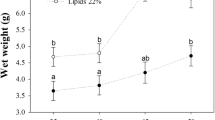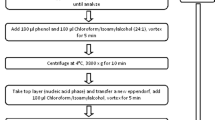Abstract
The changes in proximate composition, amino acid (total and free) and fatty acid content of artificially propagated trout cod, Maccullochella macquariensis larvae from five mothers hatched, weaned and reared separately, each in two groups, one fed with Artemia naupli and the other starved, for 15 days (after yolk resorption), are presented. There was no significant change in the proximate composition of fed larvae with devlopment, but in starved larvae the protein (linearly) and lipid (curvi-linearly) content decreased significantly as starvation progressed. The essential amino acids (EAA) and non- essential amino acids (NEAA) found in highest amounts in trout cod larvae were lysine, leucine, threonine and arginine, and alanine, serine and glutamic acid, respectively. In fed larvae the total amino acid (TAA), TEAA and TNEAA content did not vary significantly as development progressed. In starved larvae the TAA, EAA and NEAA content, as well as all the individual amino acids decreased significantly (P<0.05) from the levels in day of hatch and/or yolk-sac resorbed larvae. The greatest decrease occurred in the TEAA content (7.38±0.76 at day of hatch to 1.96±0.09 15 day starved in μmoles larva−1; approximately a 74% decrease), whereas the decrease in TNEAA was about 38%. Unlike in the case of TAA distinct changes in the free amino acid (FAA) pool were discernible, from day of hatch and onwards, in both fed and starved trout cod larvae. In both groups of larvae the most noticeable being the decrease of % FEAA in TFAA, but not the % FAA in TAA. Four fatty acids together, accounted for more than 50% of the total in each of the major fatty acid categories in all larvae sampled; 16: 0, 18:1n-9, 22: 6n-3 and 20: 4n-6, amongst saturates, monoenes, n-3 PUFA and n-6 PUFA, respectively. Twelve fatty acids either decreased (14: 0, 16: 1n-7, 20: 1n-9, 20: 4n-6, 20: 5n-3, 22: 5n-3 and 22: 6n-3) or increased (18: 2n-6, 18: 3n-3, 18: 3n-6, 18: 4n-3 and 20: 3n-3) in quantity, after 15 days of feeding, from the base level in day of hatch and/ or yolk- sac resorbed larvae. The greatest increase occurred in 18: 3n-3 from 6.4±0.1 to 106.2±13.1 μg mg lipid−1 larva−1, and the greatest decrease occurred in 22: 6n-3 (181.2±12.4 to 81.4±6.2 μg mg lipid−1 larva−1). In starved larvae, at the end of 15 days, all the fatty acids, except 18: 0, 20: 3n-3 and 20: 4n-6, decreased significantly (P<0.05) from the levels in day of hatch and/or yolk- sac resorbed larvae.
Similar content being viewed by others
REFERENCES
Abi-Ayad, S.-M. E.-M., Kestemont, P. and Mélard, C. 2000. Dynamics of total lipid and fatty acid during embryogenesis and larval development of Eurasian perch (Perca fluviatilis). Fish Physiol. Biochem. 23: 233–243.
Ackman, R.G. 1967. Characteristics of the fatty acid composition and biochemistry of some freshwater fish oils and lipids in comparison with marine oils and lipids. Comp. Biochem. Physiol. 22: 907–922.
AOAC. 1990. Official Methods of Analysis of the Association of Official Analytical Chemists (ed. by K. Helrich). Association of Official Analytical Chemists, Arlington, USA. 1298 pp.
Bell, J.G., Castell, J.D., Tocher, R.G., MacDonald, F.M. and Sargent, J.R. 1995. Effects of different dietary arachidonic acid: docosahexaenoic acid ratios on phospholipid fatty acid compositions and prostaglandin production in juvenile turbot (Scophthalmus maximus). Fish Physiol. Biochem. 14: 139–151.
Conçeicão, L.E.C., van der Meeren, T., Verreth, J.A.J., Evjen, M.S., Houlihan, D.F. and Fyhn, H.J. 1997. Amino acid metabolism and protein turnover in larval turbot (Scophthalmus maximus) fed natural zooplankton or Artemia. Mar. Biol. 129: 255–265.
Dabrowski, K., Luczynski, M. and Rusiecki, M. 1985. Free amino acids in the late embryogenesis and pre-hatching stage of two coregonid fishes. Biochem. Syst. Ecol. 13: 349–356.
De Silva, S.S., Gunasekera, R.M., Ingram, B.A. and Dobson, J.L. 2001. Weaning of Australian shortfin glass eels (Anguilla australis): a comparison on the effectiveness of four types of fish roe. Aquaculture 195: 133–148.
Di Constanzo, G., Dupoertail, G., Florentz, A. and Leray, C. 1983. The brush border membrane of trout intestine: influence of its lipid composition on ion permeability, enzyme activity and membrane fluidity. Mol. Physiol. 4: 279–290.
Douglas, J.W., Gooley, G.J. and Ingram, B.A. 1994. Trout Cod, Maccullochella macquariensis (Cuvier) (Pisces: Percichthyidae), Resource Handbook and Research and Recovery Plan. Department of Conservation and Natural Resources, Melbourne. 99 pp.
Estévez, A., Ishikawa, M. and Kanazawa, A. 1997. Effect of arachidonic acid on pigmentation and fatty acid composition of Japanese flounder, Paralichthys olivaceus (Temminck and Schlegel). Aquacult. Res. 28: 279–289.
Falk-Petersen, S., Falk-Petersen, I-B., Sargent, J.R. and Haug, T. 1986. Lipid class and fatty acid composition of eggs from the Atlantic halibut (Hippoglossus hippoglossus). Aquaculture 52: 207–211.
Folch, J.M., Lee, M. and Sloane-Stanley, G.H. 1957. A simple method for the isolation and purification of total lipid from animal tissues. J. Biol. Chem. 226: 497–509.
Fraser A.J., Gamble, J.C. and Sargent, J.R. 1988. Changes in lipid content, lipid class and fatty acid composition of developing eggs and unfed larvae of cod (Gadus morhua). Mar. Biol. 99: 307–313.
Fyhn H.J. 1993. Multiple functions of free amino acids during embryogenesis in marine Fishes. In: Physiology and Biochemistry of Fish Larval Development. pp. 299–308. Edited by B.T. Walther and H.J. Fyhn. University of Bergen, Norway.
Gunasekera R.M., Gooley G.J. and De Silva S.S. 1998. Characterisation of the ‘swollen yolk sac syndrome’ in the Australian freshwater fish Murray cod, Maccullochella peelii peelii (Mitchell) (Percichthyidae), and associated nutritional implications for large scale aquaculture. Aquaculture 16: 69–85.
Gunasekera, R.M., De Silva, S.S. and Ingram, B.A. 1999a. Early ontogeny related changes of the fatty acid composition in trout cod, Maccullochella macquariensis and Murray cod, M. peelii peelii. Aquat. Liv. Resour. 12: 219–227.
Gunasekera R.M., De Silva S.S. and Ingram B.A. 1999b.The amino acid profiles in developing eggs and larvae of the freshwater Percichthyid fishes, trout cod, Maccullochella macquariensis and Murray cod, M. peelii peelii. Aquat. Liv. Resour. 12: 255–261.
Gunasekera, R.M., Leelarasamee, K. and De Silva, S.S. 2002. Lipid and fatty acid digestibility of three oil types in the Australian shortfin eel, Anguilla australis. Aquaculture 203: 335–347.
Ingram, B.A. and Douglas, J.W. 1995. Threatened fishes of the world: Maccullochella macquarensis (Cuvier, 1829) (Percichthyidae). Env. Biol. Fishes 43: 38.
Ingram, B.A. and Rimmer, M.A. 1992. Induced breeding and larval rearing of the endangered Australian freshwater trout cod, Maccullochellamacquariensis (Cuvier) (Percichthyidae). Aquacult. Fish. Manag. 24: 7–17.
Ishizaki, Y., Masuda, R., Uematsu, K., Shimizu, K., Arimoto, M. and Takeuchi, T. 2001. The effect of docosahexaenoic acid on schooling behaviour and brain development in larval yellowtail. J. Fish Biol. 58: 1691–1703.
Koven, W.M., Kissil, G.W. and Tandler, A. 1989. Lipid and n-3 requirement of Sparus aurata larvae during starvation and feeding. Aquaculture 79: 185–191.
Koven, W.M., Tandler, A., Sklan, D. and Kissil, G.W. 1993. The association of eicosapentaenoic and docosahexaenoic acids in the main phospholipids of different age Sparus aurata larvae with growth. Aquaculture 116: 71–82.
Mourente, G. and Vázquez, R. 1996. Changes in the content of total lipid, lipid classes and their fatty acids of developing eggs and unfed larvae of the Senegal sole, Solea senegalensis Kaup. Fish Physiol. Biochem. 15: 221–235.
Pollard, D.A., Ingram, B.A., Harris, J.H. and Reynolds, L.F. 1990. Threatened fishes in Australia-an overview. J. of Fish Biol. 37 (Suppl. A): 67–78.
Rønnestad, I. and Fyhn, H.J. 1993. Metabolic aspects of free amino acids in developing marine eggs and larvae. Rev. Fish. Sci. 1: 239–259.
Rønnestad, I., Robertson, R. and Fyhn, H.J. 1996. Free amino acids and protein content in pelagic and demersal eggs of tropical marine fishes. In: The fish egg. pp. 81–84. Edited by D.D. MacKinlay and M. Eldridge. American Fisheries Society
Rönnestad, I., Koven, W.M., Tandler, A., Harel, M. and Fyhn, H.J. 1994. Energy metabolism during development of eggs and larvae of gilthead sea bream (Sparus aurata). Mar. Biol. 120: 187–196.
Rönnestad, I., Finn, R.N., Lein, I. and Lie, Ø. 1995. Compartmental changes in the contents of total lipid, lipid classes and their associated fatty acid in developing yolk-sac larvae of Atlantic halibut (Hippoglossus hippoglossus L.). Aquacult. Nutr. 1: 88–97.
Sargent, J.R. 1995. Origins and functions of egg lipids: nutritional implications. In: Broodstock Management and Egg and Larval Quality. pp. 353–372. Edited by N.R. Bromage and R.J. Roberts. Blackwell Science, Oxford.
Sargent, J.R., Bell, M.V., Henderson, R.J. and Tocher, D.R. 1990. Polyunsaturated fatty acids in marine and terrestrial food webs. In: Animal Nutrition and Transport Processes. 1. Nutrition in Wild and Domestic Animals. Comparative Physiology 5: 11–23. Edited by J. Mellinger. Karger, Basel.
Sargent, J.R., Bell, M.V., Henderson, R.J. and Tocher, D.R. 1995. Requirement criteria for essential fatty acids. J. Appl. Ichthyol. 11: 183–198.
Soivio, A., Niemistö, M. and Bäöckström, M. 1989. Fatty acid composition of Coregonus muksun Pallas: changes during incubation, hatching, feeding and starvation. Aquaculture 79: 163–168.
Srivastava, K., Brown, J.A. and Shahidi, F. 1995. Changes in the amino acid pool during embryonic development of cultured and wild Atlantic salmon (Salmo salar), Aquaculture 131: 115–124.
Tandler, A., Watanabe, T., Satoh, S. and Fukusho, K. 1989. The effect of food deprivation on the fatty acid and lipid profile of red seabream (Pagrus major) larvae. Brit. J. Nutr. 62: 349–361.
Tacon, A.G.J. and Cowey, C.B. 1985. Protein and amino acid requirements. In: Fish Energetics: New Perspectives. pp. 155–183. Edited by P. Tytler and P. Calow. Croom Helm, London.
Tocher, D.R., Fraser, A.J., Sargent, J.R. and Gamble, J.C. 1985. Fatty acid composition of phospholipids and neutral lipids during embryonic and early larval development in Atlantic herring (Clupea harengus L.). Lipids 20: 69–74.
Wilson, R.P. and Poe, W.E. 1985. Relationship of whole body and egg essential amino acid patterns to amino acid requirement patterns in channel catfish, Ictalurus punctatus. Comp. Biochem. Physiol. 80B: 385–388.
Yamada, M. 1972. New observations on the lipids of aquatic origin. Mem. Fac. Fish. Hokkaido Univ. 19: 35–36.
Author information
Authors and Affiliations
Corresponding author
Rights and permissions
About this article
Cite this article
Gunasekera, R.M., De Silva, S.S. & Ingram, B.A. Chemical changes in fed and starved larval trout cod, Maccullochella macquarensis during early development. Fish Physiology and Biochemistry 25, 255–268 (2001). https://doi.org/10.1023/A:1023247718139
Issue Date:
DOI: https://doi.org/10.1023/A:1023247718139




